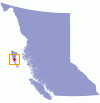Access around the island is limited by there being only about 30 km of road, and the topography of the coastline is so complex, boat access is the best choice.
Highlights:
Activities include wildlife tours, sport fishing, camping, cycling and the study of native history, particularly of ancient Haida villages and in Gwaai Haanas National Park. Visits to these sites are organized and done under permit. The isolation of the islands has resulted in the evolution of unique subspecies and many species found on the mainland are absent on the Queen Charlottes. Its position of the ‘Pacific Flyway’ means it provides habitat for numerous migratory birds, while the ocean is rich in marine life, including migratory whales that move between Hawaii, Baja and Alaska.
History:
Before western contact on the Queen Charlottes, (the native name is Haida Gwaii, “Islands of the People”) the islands were home to approximately 50,000 people. However, after the devastating effects of disease in the 19th century, the population was cut by 90%. Today, about 5000 live there, mostly on the northern island, with those on Moresby dwelling in the small town of Sandspit.
Climate:
Care should be taken in all the waters, as the Queen Charlottes are known for their rough seas, fog and inclement weather, with waves over 30 m in height having been recorded off the west coast, and hurricane force winds not uncommon throughout the waters, on east and west.
Moresby Island Accommodations
Moresby Island Things to Do
British Columbia

